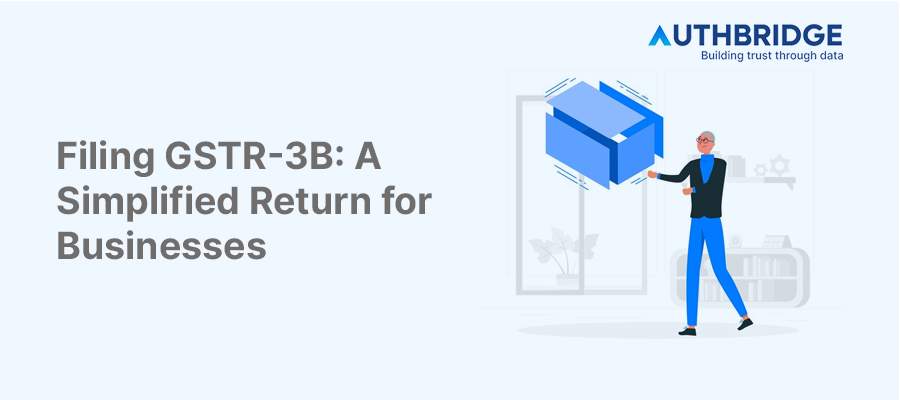Simplifying GSTR-3B Filing

Purpose and Overview
GSTR-3B is a monthly self-declared summary return filed by registered GST taxpayers. It consolidates the total value of sales and purchases, the GST collected on sales, and the GST paid on purchases, allowing taxpayers to declare their tax liability for a given month. Introduced as a simplified provisional return to ease the compliance burden, GSTR-3B plays a crucial role in maintaining GST compliance and facilitating the smooth operation of the GST regime.
Key Features of GSTR-3B
- Simplified Format: GSTR-3B is designed to be straightforward, requiring only aggregate values rather than invoice-level detail.
- Mandatory for All GST Registered Businesses: Except for a few exemptions, all businesses registered under GST are required to file GSTR-3B.
- Facilitates Tax Payment and ITC Claim: It allows taxpayers to pay outstanding tax and claim eligible Input Tax Credit (ITC).
Eligibility Criteria for Filing GSTR-3B
Who Needs to File
All GST-registered businesses, including traders, manufacturers, and service providers, are required to file GSTR-3B, irrespective of their turnover. This includes regular taxpayers, those under the composition scheme (with specific conditions), and non-resident taxable persons.
Exemptions and Special Cases
Certain categories of registrants, such as Input Service Distributors (ISD), persons liable to collect TCS, and those liable to deduct TDS, may have different filing requirements or exemptions. It's essential to refer to the latest GST notifications for up-to-date information on exemptions.
Preparing for GSTR-3B Filing
Essential Documents and Information
To accurately file GSTR-3B, businesses should gather:
- Sales and purchase invoices, including debit and credit notes.
- Details of outward and inward supplies, segregated into taxable, exempt, nil-rated, and non-GST supplies.
- Information on imports, exports, and supplies made to SEZs (Special Economic Zones).
- Input Tax Credit (ITC) details available from GSTR-2A for reconciliation.
Understanding Taxable Supplies
Taxable supplies include all goods and services sold or provided that are liable to GST. It's crucial to classify these correctly according to the applicable GST rates (5%, 12%, 18%, and 28%) and to distinguish between inter-state and intra-state supplies for accurate tax calculation.
Step-by-Step Guide to Filing GSTR-3B
Accessing the GSTR-3B Form
- Log in to the GST portal (gst.gov.in).
- Navigate to the 'Services' > 'Returns' dashboard and select the relevant tax period for GSTR-3B.
Filling Out the Form: A Section-wise Breakdown
- Section 3.1: Report total taxable outward supplies, including details of supplies liable to reverse charge.
- Section 3.2: Detail interstate supplies made to unregistered persons, composition taxable persons, and UIN holders.
- Section 4: Declare eligible ITC, categorized as inputs, input services, and capital goods.
- Section 5: Disclose values of exempt, nil-rated, and non-GST inward supplies.
- Section 6.1: Provide payment details of tax, interest, late fees, etc.
Submitting the Form
After verifying all entered details, submit the form using a Digital Signature Certificate (DSC) or an EVC (Electronic Verification Code). Payment of any due tax can be made through the GST portal, completing the filing process.
Common Mistakes to Avoid in GSTR-3B Filing
Inaccurate Reporting of ITC
Ensure that the ITC claimed matches the eligible credits as per invoices and GSTR-2A to avoid mismatches and potential penalties.
Misclassification of Supplies
Incorrectly classifying supplies can lead to wrong tax payments. Pay special attention to the nature of supplies and their place of supply.
Late Filing and Its Implications
Late filing of GSTR-3B attracts a penalty and interest. It's crucial to adhere to the filing deadlines to avoid these additional costs.
Rectifying Errors in Filed GSTR-3B
Process for Making Corrections
Errors identified in a filed GSTR-3B can be corrected in the return of the subsequent month(s). Adjustments should be made carefully to ensure they reflect accurately in future filings.
Impact of Late Corrections
Late corrections can lead to discrepancies in tax liability and ITC claims, affecting financial statements and compliance status. Regular reconciliation and timely action are advisable.
Tips for Efficient GSTR-3B Filing
Regular Reconciliation Practices
Regularly reconcile books of accounts with GSTR-2A and GSTR-3B filings to ensure accuracy in reported figures and ITC claims.
Leveraging Technology for Compliance
Use GST-compliant accounting software to automate and streamline the preparation and filing of GSTR-3B. This can significantly reduce errors and save time.
Conclusion
Filing GSTR-3B is a critical compliance requirement for businesses under the GST regime. By understanding the filing process, avoiding common pitfalls, and adopting best practices for preparation and reconciliation, businesses can ensure accurate and timely submissions. Staying informed about GST regulations and leveraging technology will further aid in simplifying the compliance process, allowing businesses to focus on their core operations while remaining compliant with GST laws.
Category

Abhinandan Banerjee
(Associate Manager - Marketing)
Abhinandan is a dynamic Product and Content Marketer, boasting over seven years of experience in crafting impactful marketing strategies across diverse environments. Known for his strategic insights, he propels digital growth and boosts brand visibility by transforming complex ideas into compelling content that inspires action.



